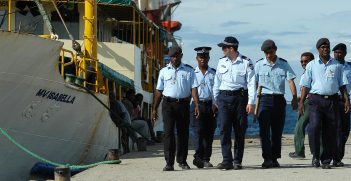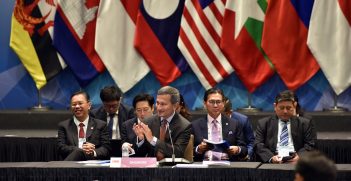What Role can the Pacific Islands Play in Strengthening Australia’s Security?

It is common for Australian politicians, policymakers and commentators to talk about security in the Asia-Pacific region, but what they are really referring to is Asia. However, if we are to strengthen Australia’s security, we can’t forget the Pacific in the Asia-Pacific.
The Pacific Islands lie across some of Australia’s most important strategic approaches. Reflecting this, Australia has long been anxious about its proximity to the Pacific Islands, the region’s vulnerability to penetration by potentially hostile powers and its distance from its major security allies: first the UK, later the US.
Accordingly, Australian defence planners have articulated two primary strategic interests in the Pacific Islands: first, to ensure that no power hostile to Western interests establishes a strategic foothold in the region from which it could launch attacks on Australia or threaten allied access or its maritime approaches. Second, to ensure ‘security, stability and cohesion’ in the region.
Australia also has significant economic interests in the region; thousands of Australians live there, and many more visit each year.
Australia’s anxiety about the Pacific Islands peaks when the region is perceived to be a source of threat, such as during the 1880s when European states were colonising the region; during World Wars I and II when Germany and then Japan penetrated the region; during the height of the Cold War when the USSR and Libya made overtures to Pacific Island states; between 2003 and 2006 when the region was perceived as a potential site for the ‘war on terror’; and now, as external powers, such as China and Russia, whose interests may be inimical to Australia’s, become increasingly active in the region.
Australia has perceived that Pacific Island states are vulnerable to penetration by potentially hostile external forces because they are often characterised as ‘unstable, fragile or weak’, manifesting in the label ‘arc of instability’ dominating Australian perceptions of the region during much of the 2000s.
This negative portrayal was resented in the Pacific Islands and has meant that Australia has come to view the region principally as a security threat.
Moreover, as Australia has primarily viewed the Pacific Islands through the lens of its own security, this has meant that it often fails to recognise when and how its security concerns differ from those of Pacific Island states and their people. This has undermined the success of Australia’s activities in the region, and may even have made some Pacific Islanders feel less secure.
Consequently, for the past couple of years I have argued that Australia’s security would be strengthened, as would its relationships in the Pacific Islands, if negative portrayals were replaced by a more positive characterisation of the region as an ‘arc of opportunity’.
This is intended to highlight the potential and opportunities of Pacific Island states, rather than their perceived weaknesses. Indeed, Foreign Minister Julie Bishop has recognised that the region is one “of great opportunity”.
The arc of opportunity characterisation focuses on two sets of opportunities. First, for Australia to recognise and capitalise on opportunities for strengthening and developing Pacific Island states to bolster its own security. Second, for Pacific Island states to take advantage of opportunities available to them, including Australian support to improve stability and advance development.
Viewing the Pacific Islands as an arc of opportunity may encourage Australia to see itself more as a regional partner rather than a regional power. This may encourage Australia to work more with Pacific Island states as its partners to achieve stability. More stable Pacific Island states could provide a security screen for Australia that meets its strategic interest in ensuring that no power hostile to Western interests establishes a foothold in the region, something that may become vital in the increasingly likely event that the broader Asia-Pacific region becomes more threatening.
Guided by the arc of opportunity recharacterisation in my recent book, Pacific Power? Australia’s strategy in the Pacific Islands, I identify opportunities for Australia to change its approach to the Pacific Islands. They relate to:
- how Australia conducts military intervention;
- Australia’s defence assistance, including the Defence Cooperation Program and Pacific Maritime Security Program;
- Australia’s humanitarian and disaster relief, including the potential of ‘disaster diplomacy’;
- how Australia provides state-building assistance, understood as including both governance and law and order assistance;
- the way in which Australia uses its economic tools of aid, trade and investment;
- how Australia conducts its diplomacy;
- how Australia may seek to ensure that the geopolitical landscape of the region enhances, rather than undermines, its security; and
- how Australia could better use regional institutions to engage with Pacific Island states and enhance its security.
It’s time for Australia to stop seeing the Pacific Islands as a problem for Australia’s security and to stop being anxious about its proximity to the region. Instead, Australia should see the Pacific Islands as an arc of opportunity, made up of states with strong communities and societal structures, resilient populations and rich natural resources.
If Australia approaches the region as a Pacific partner, rather than power, to capitalise on both opportunities for Australia and for Pacific Island states, a stronger and more prosperous region could play an important role in securing Australia in the future.
Joanne Wallis is a senior lecturer in the Strategic and Defence Studies Centre at the Australian National University. She is the recipient of the AIIA National Publication Support Grant for her book ‘Pacific Power? Australia’s Strategy in the Pacific Islands’.
This is an article based on her address to the 2017 Australian Institute of International Affairs National Conference.
This article is published under a Creative Commons Licence and may be republished with attribution.





